ASUS ProArt PA32UCG: The Ultimate Mini LED 4K 120 Hz Monitor with HDR 1600
by Anton Shilov on September 4, 2019 3:00 PM EST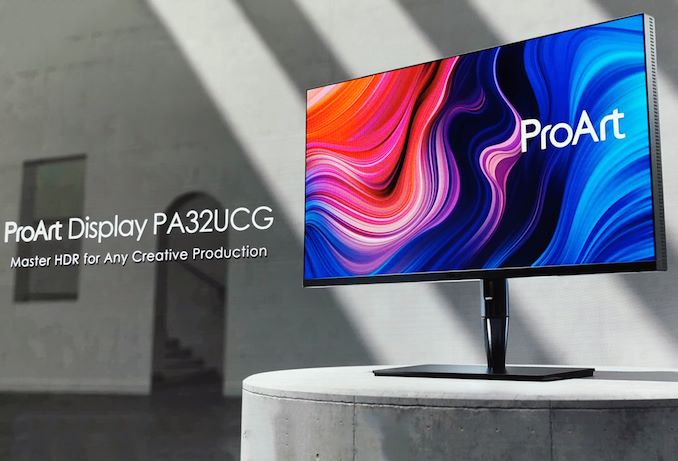
Content creation is about to change drastically in the coming years as ultra-high-definition displays with wide color gamut, superior refresh rates, and great contrasts become widely available and demand for high-quality visuals increases. Being one of the leading makers of professional monitors, ASUS cannot ignore the ongoing trends and develops professional displays for next-gen content creation workloads. At IFA today, the company announced its ProArt PA32UCG LCD, one of the most advanced professional monitors introduced to date.
To meet above mentioned requirements for next-generation displays, ASUS (and other makers of monitors) has to use either bright OLED panels with all their pros and cons, or advanced IPS LCD panels featuring full-area local area dimming (FALD) backlighting enhanced with quantum dots (or other methods) for more accurate colors. With its ‘portable’ ProArt PQ22UC, the company decided to go OLED, but with the new ProArt PA32UCG (and similarly-sized LCDs for color-critical workloads), the company prefers IPS panels featuring the said treatments.
Aimed primarily at game developers, the ProArt PA32UCG features a 10-bit IPS panel of 3840×2160 resolution that offers a variable refresh rate (VRR) between 48 Hz and 120 Hz and is equipped with a Mini LED-based backlighting featuring 1,152 individual local dimming zones and quantum dots. That backlighting enables 1000 nits sustained brightness, up to 1600 nits peak brightness in HDR mode (officially, the LCD carries VESA’s DisplayHDR 1400 badge though), and a very high contrast ratio.
The ASUS ProArt PA32UCG monitor can display 1.07 billion of colors and reproduce the sRGB, Adobe RGB, DCI-P3, and Rec. 2020 color spaces used for video post-production as well as graphics design nowadays, yet ASUS does not disclose anything about percentage of the coverage. Meanwhile, since the display will come factory calibrated with a Delta <1 accuracy, expect its color reproduction to be very precise. To ensure this when deployed, the display will come with a light-shielding hood.
Additionally, the LCD supports HDR10, Dolby Vision as well as hybrid log gamma (HLG) HDR formats, but there is no word about HDR10+ support. ASUS also does not reveal anything about internal 3D LUTs (look up tables) for HDR gradations, but only mentions multiple PQ curves to fit users’ needs. This is explainable though as the product is many months away from its commercial launch.
As for connectivity, ASUS so far has only confirmed Thunderbolt 3 support, but it is logical to expect DisplayPort 1.3/1.4 as well as HDMI 2.1 (since we have VRR here) connectors to be present as well.
The company demonstrated the ProArt PA32UCG monitor at its IFA 2019 event, so we know that the monitor works and probably is in its final stages of development.
| Specifications of the ASUS ProArt Mini LED 4K 120 Hz Display | |
| ProArt PA32UCG | |
| Panel | 32" IPS |
| Native Resolution | 3840 × 2160 |
| Maximum Refresh Rate | 48 - 120 Hz VRR |
| Response Time | unknown |
| Brightness | 1000 cd/m² (sustained) 1600 cd/m² (peak) |
| Contrast | high |
| Viewing Angles | 178°/178° horizontal/vertical |
| HDR | HDR10, Dolby Visin, HLG |
| Backlighting | Mini-LED-based 1152-zone FALD |
| Pixel Pitch | 0.1845 mm² |
| Pixel Density | 138 ppi |
| Display Colors | 1.07 billion |
| Color Gamut Support | DCI-P3 Adobe RGB Rec. 2020 sRGB |
| Aspect Ratio | 16:9 |
| Stand | Hight, Tilt, and Swivel adjustable |
| Inputs | Thunderbolt 3 DisplayPort (?) HDMI 2.0 (?) |
| USB Hub | ? |
| Launch Date | Q1 2020 |
ASUS intends to bring its ultimate ProArt PA32UCG to the market sometimes in the first quarter of 2020 if everything goes as planned. The company naturally does not talk about prices just yet.
Related Reading:
- ASUS Mini LED Professional Monitors Update: Available This Year
- ASUS at CES 2019: ProArt PA32UCX 4K Monitor with 1000-Zone FALD Unveiled
- Acer Joins Mini LED Monitor Club with Professional-Focused ConceptD CM7321K
- AUO’s Mini LED Monitors: 32-Inch 4Kp144, 65-Inch 4Kp144, VR, & Others
- Dell Launches 55-Inch Alienware OLED Display: 4K at 120 Hz with Deep Blacks
Source: ASUS









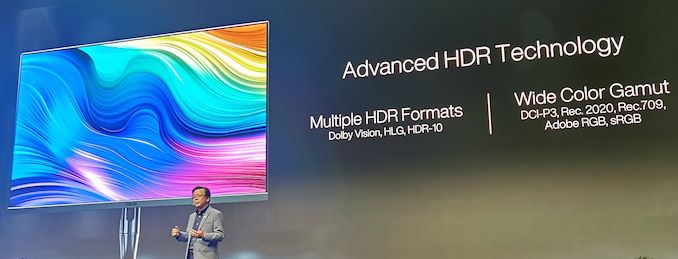
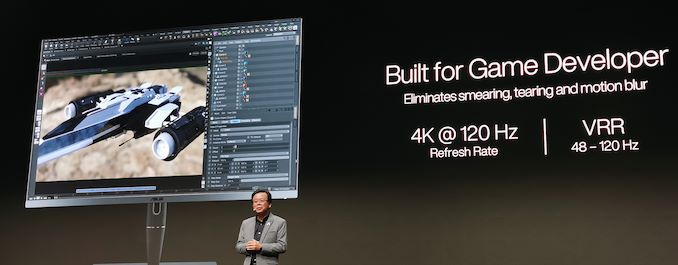

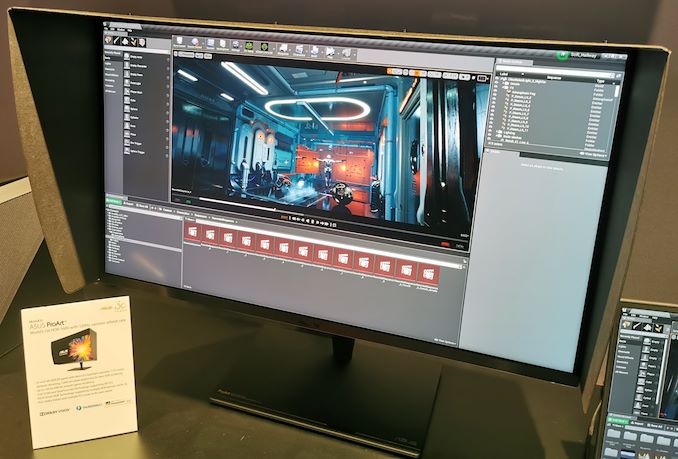
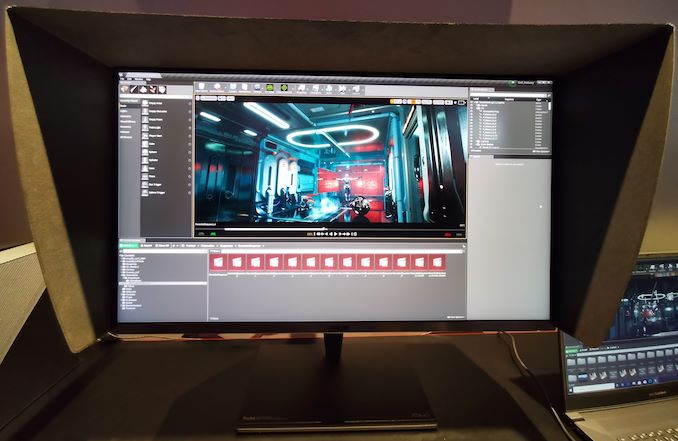









34 Comments
View All Comments
Alistair - Wednesday, September 4, 2019 - link
Yeah Asus has a tendency to outright lie about release dates. 2021.DesktopMan - Thursday, September 5, 2019 - link
The 60 hz version was supposed to be out in June and it's nowhere to be seen so this is spot on.Also regarding the article, VRR doesn't automatically mean HDMI-VRR unless stated.
lilkwarrior - Saturday, January 4, 2020 - link
Not Asus's fault at all; it's AUO. They're kinda heartless pushing back high-end panels for maximizing their profits selling lower-end panelsDanNeely - Thursday, September 5, 2019 - link
You can't bring a product out on time when a key component supplier blows availability times by over a year; and AUO was embarrassingly over optimistic about how quickly they could get their first generation FALD panels debugged.Morawka - Wednesday, September 4, 2019 - link
wtb a good proart with HDR and 120hz for under $700haukionkannel - Thursday, September 5, 2019 - link
Hdr 400 or even less for that price...edzieba - Thursday, September 5, 2019 - link
I wonder what they're using to drive the backlight in VRR mode. Current implementations have been G-sync (big grunty FPGA and huge backlight driver boards) to get the FALD updated per-frame and in sync with panel updates, or the TV route using stock panel controllers where either FALD is disabled for VRR (static backlight only, no HDR) or operates using a trailing multi-frame average ('glow streaks').lilkwarrior - Saturday, January 4, 2020 - link
HDMI 2.1 ideally. Turing GPUs can handily render adaptive-sync that way + two 2080Tis easily max out the refresh frates of this monitor (one can get 70-80FPS easily and will be way faster in more modern games coming out when Windows 7 is EOL'd and games + apps can use WDDM 2.0)lilkwarrior - Saturday, January 4, 2020 - link
*As far as the game developer use case of this monitor. One 2080TI is more than enough for general usage of this monitor at 4K@120hz.stanpapusa - Saturday, October 12, 2019 - link
Oh please, can I laugh?PA32UCX was announced nearly a year ago, and for most of 2019 various media outlets kept announcing it, since there was no new information available.
Given the price and availability as of Oct 2019, I'm pretty sure people are queuing around the block to buy it. Mind you, it's still far from pixel level illumination and still costs an arm and a leg.
And now we're already talking about 1600 nits and 120 Hz?
Let me guess, it will be widely available in 2022 and cost 10k?
As Bill Maher put it "Mars might be full of methane, but we are full of s**t"